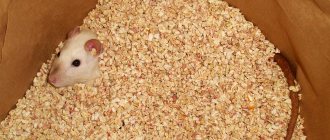Caring for a decorative rat does not have to be too difficult. The beauty of pet rodents is that even children can be entrusted with caring for them. But for this you need to properly organize the rat’s life. Choose the cage and filler wisely, and choose accessories.
And this is more difficult than it seems. Pet store salespeople are no help here. They may not understand rats at all, and their motive is simple - to sell what they have in the store.
As a result, opinions appear on the Internet that supposedly rats stink terribly. That caring for a pair of rats is more difficult than caring for three cats. And the fact that the animals were sitting in an aquarium or a tiny hamster cage remains “behind the scenes.”
Proper care allows you to enjoy interacting with rats without side effects. It is worth noting that there is no single correct solution. You need to choose a filler and the type of cage depending on the habits of the rats themselves and their owners. What is convenient for one may not be suitable for others.
In this article I will talk in detail about the various options for keeping decorative rats. It is better to take care of the housing issue even before the appearance of tailed pets.
Author of the article: Olga Shiltsova, practicing veterinarian, author of the books “Dachshund of Fate” and “Tails of Fortune”
Features of a cage for domestic rats
For conscious rodent owners, a rat cage is a safe space, a home and a small gym. Before choosing a cage for your pet, take a few minutes to learn about the features of a cage that is suitable for large rodents.
- Cage material
Rat cages can be made from a variety of materials, including metal wire, plastic, and wood. Considering that your rat will be living, eating and drinking inside the cage, consider choosing a material that is odor-resistant and durable enough to withstand damage in case your furry companion decides to chew on the cage.
Metal is the best cage material for rats because it is inexpensive, durable, and chew-resistant. However, if you choose a metal cage, make sure it will not rust over time. It must be treated with a special anti-corrosion coating.
Plastic and wood can be good options for ramps or for lining the bottom of the cage, but keep in mind that both of these materials can be chewed by your pets. To prevent this from happening, make sure your rats are happy and entertained with innovative climbing structures, chew toys, and daily outside play.
- Distance between rods
Rats can fit through very small spaces. So, if the gap between the bars in your cage is large enough for your rat's head, he will be able to escape. To keep your pets safe while you're away, look for a rat cage with a door that has a secure locking mechanism.
For small rats you will need a cage with 1cm spacing between the bars. Adult rats can be kept in cages with wider bar spacing, but it is not recommended to rely on cages with bar spacing greater than 2 cm.
When you choose a location for your rat cage, make sure it is:
- away from windows and drafts;
- away from direct/constant sunlight, although the room will require a natural source of daylight;
- safe from other pets such as cats and dogs;
- safe from small unattended children;
- away from constant loud noise, such as a TV or music system;
- in a family friendly place to provide plenty of socializing.
What should the cell size be?
Most pet rats spend most of their time in a cage—sometimes up to 22 or 23 hours a day. So, it should be spacious enough to give the rats enough space to explore and be active.
The exact size of the cage depends on the number of rats you have. Its goal is to provide rats with a complete habitat with many different areas to dig, climb, run, sleep and forage for food. The standard cage size for one or two rats is 72cm x 36cm x 44cm, but if you have more rats you will need to choose a larger size.
When choosing a cage for two or three rats, keep these minimum dimensions in mind:
- Depth: 80 cm
- Width: 50 cm
- Height: 80 cm
If you plan to keep a group of 10 rats, remember the following minimum sizes:
- Depth: 93 cm
- Width: 63cm
- Height: 123 cm without stand
There are several starter cage types that may be a good choice if you have little rats. But you need to keep in mind that rats grow quite quickly and will outgrow their small cage in 3-4 months. It will probably be better to buy an adult rat cage outright and save money.
When it comes to rat cage size, it is best to choose a larger cage. Rats need a lot of space to roam, climb and play, so they will be unhappy living in a small cage. More is always better! However, large cages are only beneficial for rats if they are well designed and the space is put to good use. Proper cage installation is just as important as choosing the right size cage.
Rod options
So, as we have already figured out, the rods must be metal, but it is very important whether they are galvanized or painted. Galvanized ones are subject to corrosion, which is impractical and even dangerous; painted ones are durable and will last a long time.
Remember that the rods must be securely welded and always have a rounded shape. For small rats, the distance between the rods should not exceed 0.7-1 cm, and for adults 1.2-1.5 cm.
How to set up a rat cage
Your rat cage should include features and functions that make your pet easier to care for and also keep him happy. For example, some cages come with removable food and water containers that can be filled and replaced without removing the rodent from the cage.
Rat cages require the following accessories:
- Containers for food and water.
It is better to choose a bowl made of ceramic material of medium and small size, intended for small animals. Always place the bowl away from the sides of the cage to prevent it from falling and crushing one of your pets. Make sure it is not located under the water bottle, otherwise water will drip and spoil the food. - Houses.
Sometimes rodents like to be alone and a house is perfect for a rodent's privacy. - Hammocks.
Rats love sleeping in them and encourage them to have grooming sessions with their cage mates and feel relaxed around you. Hammocks can be bought or homemade from old jumpers, towels and sheets. - Tray.
These pets can be taught to go to the toilet in a certain place. It is worth purchasing a tray, as well as a safe filler for it.
Best lists
All cages presented in this rating provide rats with comfortable living conditions and do not pose a risk to the health of the animals. I also identified three favorites that additionally stand out from other models due to price, size or ultimate quality.
IterZoo Teddy Gigant G089 – the best economy offer
A cage from a Polish brand is an excellent solution for a novice rat breeder who does not yet plan to have a large flock. There is enough space in it to keep a couple of animals, in addition, the dimensions of the cage will allow you to easily place a hammock and additional toys for pets in it.
Galvanized rods resist attempts to gnaw them well, and the small distance between them will allow even one-month-old rat pups to live in the Teddy Gigant G089. The cage is durable, easy to disassemble for cleaning, and in addition, it compares favorably with other models in the rating at an affordable price.
IterZoo Teddy Gigant G089
IMAC Plexi 120 Mid Wood – the best solution for breeders
The Model 120 Mid Wood is an excellent solution for the rat kennel owner who needs a large main cage that can accommodate a large flock of rats. It provides sufficient living space for up to 11 males or 15 females, and the thoughtful arrangement of the doors makes it easy to clean, add or remove pets, change water and add food.
The height of the tray is increased due to transparent walls that do not interfere with the view. Thanks to them, the floor around the cage will remain clean, even if the whole flock of rats starts an active fuss. This will be an additional advantage for breeders, as it will reduce the time spent on servicing pets.
IMAC Plexi 120 Mid Wood
Ferplast Furet - the best quality and equipment
Ferplast brand cages are considered by many breeders to be the best on the market. The Furet model is an ideal solution for the owner of a medium-sized flock. Due to the fact that the size of all parts is adjusted to the millimeter, the cage is easy to assemble and disassemble. It is “escape-resistant”, durable, and made of non-toxic materials.
An additional advantage of the model is its rich equipment. A feeder, water bowl and other accessories are supplied with the cage, which allows you to move in pets immediately after its assembly.
Ferplast Furet
Toys and exercise equipment in the cage
Just as you have many items in your home designed for your entertainment, your rat's home should have accessories that will help him exercise, relax, and have fun. Consider a rat cage that includes a hammock for rest and relaxation, plenty of tubes or ropes to climb on for exercise, and rat toys to keep your pet entertained.
Your rats will love:
- Pipes and tunnels for passage
. - Climbing towers
, such as metal CD towers. - Ropes
. You can make them yourself or buy ready-made ones. - Wheel
. It should be large and durable, designed specifically for rats. - Cardboard boxes of all shapes and sizes
. Make some holes in them to make exploring even more fun. Old jumpers, socks and soft hats are always welcome as bedding for your rats.
It is important to know!
Never give rats plastic toys that have been treated with varnish, perfume, glass cleaner or oil.
What is the price?
Everything will depend on which option you prefer. Small cages are cheaper, but they are usually purchased for small rats. Large, spacious models are more expensive, also double-tiered.
The most expensive models include cages that are fully equipped for housing. They are often equipped with feeders, drinking bowls, hammocks, ladders, horizontal bars, and houses. Such an acquisition will be profitable and very convenient for beginning breeders who do not yet know how to properly organize the space and equip it with everything they need.
Choosing the right litter for rats
Using the wrong litter for rats can have a very negative impact on their health. Wood shavings or sawdust can be extremely harmful to your rats' skin and respiratory tract and can also cause an allergic reaction.
Filling materials that are safe for rats:
- Finely chopped, shredded paper;
- Shredded cardboard suitable for the base of the cage;
- Hemp is odorless;
- Cardboard squares are about 1 cm in size, ideal for the base of the cage;
- Fleece or towels can be used in sleeping areas or as hammocks;
- Paper granules.
Comparison of the best products
For convenience, I have summarized the main characteristics of the cells in a comparative table.
| Name | Dimensions | Additional accessories | Distance between rods | Weight | Maximum number of rats |
| IterZoo Teddy Gigant G089 | 58*38*55 cm | Floors, bowls, wheels, house | 1 cm. | 3.8 kg | 2 |
| Ferplast Jenny | 80*50*79.5 cm | Floors, bowl, automatic drinker, stairs, tunnel | 0.8 cm | 9.2 kg | 5-7 |
| Savic Freddy 2 | 80*50*63 cm | Corner floor, toilet, bowl, drinking bowl, stairs, hammock | 0.95 cm | 7.7 kg | 4-5 |
| Imac Rat 80 Mid | 80*49*63 cm | Two floors bowl, two stairs | 1 cm | 9 kg | 4-5 |
| Ferplast Furet | 78*48*70 cm | Shelf floor, solid ladder, bowl, automatic drinking bowl, hammock, corner toilet | 1 cm | 7.5 kg | 4-6 |
| IMAC Plexi 120 Mid Wood | 120*60*93 cm | Two floors, two houses, three stairs | 1.2 cm | Not specified by the manufacturer | 11-15 |
Proper cage care
Keeping your rat cage clean is key to preventing serious illnesses such as respiratory illnesses and painful paw infections. Clean your rats' litter trays or litter trays daily, rinse any soiled areas with pet disinfectant, and wipe dry with wipes.
Perform a thorough cleaning of the entire cage once a week, making sure to also clean all toys and exercise equipment with a rat-friendly disinfectant. Machine wash hammocks and any other fabric using non-biological detergent at 60°C to kill as many bacteria as possible.
Take the opportunity to add a few new toys to the cage for interest, such as a new tunnel, hammock or rope ladder, cardboard boxes filled with something are also great for rats to explore.
Let's sum it up
Before buying a cage and any accessories, you need to think carefully about all the points and make sure that these purchases will be correct, useful and safe for the animal.
You should not overload your home with all sorts of objects; they should be useful and not hinder the rodent’s movements and deprive it of free space. Most items can be made independently at home, for example, hammocks, houses, beds, shelves, ladders, so the owners can show their imagination.











